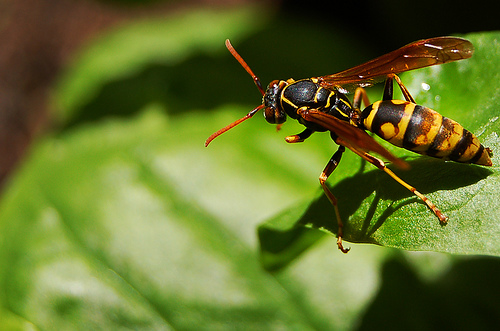Send your question to Umbra!
Q. Dear Umbra,
Every time the weather gets warmer, it’s the same: the wasps! They insist on trying to make their home in my balcony! I tried many different things, like citronella candles, but some of them apparently attract instead of repelling wasps. I don’t want to kill them; I just want to keep them away! Also, if I don’t do anything effective, the landlord will notice and will kill them himself with whatever harsh insect killer he has in hand!
Please help!
Thabata
A. Dearest Thabata,
 Photo: VancityAllie via FlickrMy word processor wants to change your name to Tabatha, but I won’t let it.
Photo: VancityAllie via FlickrMy word processor wants to change your name to Tabatha, but I won’t let it.
Before we talk about how to get rid of wasps, let’s give them their due as helpful insects. Most wasps are actually quite beneficial to the ecosystem as predators to other insects like caterpillars, which can wreak havoc on a garden. But wasps can be nasty too, so what to do with your balcony colony.
Generally, wasps avoid us humans. But, as you obviously know, when the nest is near a house, it’s got to go. Your desire to avoid the fury of a wasp sting (I have—it’s no picnic, my friend) is understandable; your desire not to harm the wasps admirable.
The first suggestion—too little, too late for your situation, Thabata, but good for future reference—is an ounce of prevention: Seal off any places where wasps can enter your home; this includes unsealed vents, ripped screens, and gaps around windows and door frames. Also, remove or cover any outdoor food sources like bowls of pet food, garbage cans, or compost piles. These crafty little insects can actually imprint food sources, which means they’ll remember and return to an area where they’ve found food before, even after the food has been removed.
A word of caution: If you do have a wasp in your sights, I know squashing it may sound like a satisfying, nontoxic way to deal, but please refrain. Aside from the possibility of getting stung, the squished wasp releases pheromones that attract other wasps—perhaps to avenge its death.
I found this handy video on making your own wasp trap from a used plastic bottle and a coat hanger, as well as some readymade glass wasp catchers. Both lure wasps into a vessel with fruit juice as bait. Once the wasps have succumbed to the fruit juice’s siren call, they are unable to scramble out of the bottle. You just empty the container out when you feel like you’ve got a full house in there. (I know you aren’t keen on killing your wasps, and I’m not sure about their survival rate in this scenario so use it with care.)
I also came across the Waspinator, which resembles a real wasp nest and apparently acts as a sort of scarecrow for wasps. No clue if it actually does the job, but I love the name.
There are tips aplenty out there on removing the wasp nest yourself, though I don’t feel comfortable recommending that potentially harmful course of action. Calling in a professional to remove the nest is not the worst possible option. You just need to ask what wasp eliminating methods they use. Some exterminators avoid toxic chemicals in favor of a vacuum that sucks the wasps out of the nest. This probably doesn’t turn out well for the wasps, but at least it’s a nontoxic way to keep your family from feeling the sting.
And last but not least, Thabata, you could just throw in the towel and move.
Yellow jacketly,
Umbra
Q. Dear Umbra,
Thanks for answering our questions all the time. Where do you suggest one starts their research if we want to find our own answers?
Mark
A. Dearest Mark,
Well, you’re quite welcome. I do hope you’ll keep the questions coming even if I let you in on a few of my secrets. See, I have this Magic 8 Ball … OK, not really. Basically, I have an inquisitive mind, a telephone, and the internet.
And while I don’t want to talk, er, write myself out of the job, I will share some of my favorite sites when it comes to beginning my research for your questions: Environmental Working Group, Green Your, and Earth 911. I also appreciate being able to call on organizations like Sierra Club, Natural Resources Defense Council, and Union of Concerned Scientists for information.
Otherwise, I just ask a lot of questions of a lot of different people. I think sometimes in life we rely too heavily on finding answers online. But, as you know, there is a lot of unreliable information that turns up in an internet search. So don’t be afraid to pick up the phone. Sometimes a simple phone call is all it takes.
Answeringly,
Umbra
Q. Dear Umbra,
Is it “greener” to run a home laptop off its battery and then recharge or to always keep it plugged in?
Cameron
A. Dearest Cameron,
So you like vampires? I’m not talking about Edward and Bella (sorry, Twihards). I’m talking energy vampires, phantom loads (I love all the creepy names)—like that plugged-in laptop. I covered this issue in depth a few times in recent years, so if you want the deep dive, please click, click, click away.
Simply stated, unplug that laptop whenever you’re not using it, or plug it into a power strip that you flip off when not in use. Whether you run the battery all the way down before charging it doesn’t really matter in terms of energy use (computer geeks of the world, if there’s some reason why one should or shouldn’t do this in terms of computer health, please feel free to weigh in). But if you are one of those people who runs the battery all the way down, you might also have a tendency to leave your laptop plugged in longer than necessary to charge the battery—and that turns your laptop into an energy-sucking vampire. I’d just plug it in when you’re using it or when the battery is in need of some juice. Thanks for not sucking.
Team Jacob-ly,
Umbra



